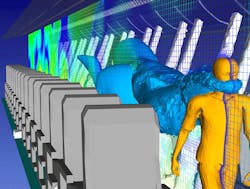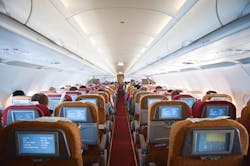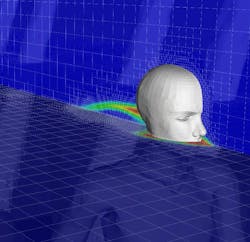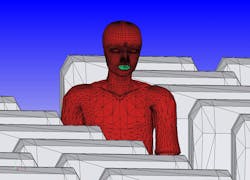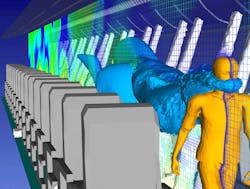CFD Software Automatically Models How Moving Parts Affect Airflow
Engineers typically model airflow in environments with computational fluid-dynamics (CFD) software. But most CFD models force designers to manually map the meshes that define the environment’s boundaries. The user has to guess where to refine meshes and assume the meshes will provide sufficiently accurate results. That means no two meshes are ever the same and, therefore, no two results are same. It also makes it hard to predict flow fields inside complex environments with moving components.
So software engineers at Convergent Science Inc., Middleton, Wis., have simplified how researchers and designers model fluid dynamics by developing Converge. The software automatically generates meshes so users can spend more time analyzing simulations.
The software could soon help engineers boost the efficiency of cabin cooling, heating, and filtration on commercial airliners. A good environmental control system (ECS) can boost passenger comfort and minimize the spread of airborne pathogens.
To perform CFD analysis, users import STL files of both the cabin and passengers. Then they specify boundary conditions with details about passenger movement and how ECS climate-control nozzles above each seat push air about the cabin. When the PC runs the computations to solve the model, the software makes new meshes every time-step, rendering cases with moving points as simple to analyze as static cases.
Users can also specify passive scalars for the software to solve —lines in model animations that let users visualize how passive flow interacts with active flow. For aircraft-cabin models, the software tracks two passive scalars: one that shows airflow from an ECS jet and another that shows airflow from a potentially contagious passenger’s breathing.
Accurate results rely on sufficient mesh resolution, but an aircraft-cabin domain is too large to finely mesh everywhere. So the software adds mesh elements only when and where needed. To specify higher fineness of important shapes in the model, users employ a boundary-embedding tool. Another tool, adaptive mesh refinement, adds more cells during every runtime time-step wherever it detects large field-variable gradients. That maximizes model accuracy while minimizing runtime. In the case of aircraft-cabin modeling, the software applies adaptive mesh refinement around the ECS jets and passenger breath to a maximum cell count of 7 million.
About the Author
Elisabeth Eitel
Elisabeth Eitel was a Senior Editor at Machine Design magazine until 2014. She has a B.S. in Mechanical Engineering from Fenn College at Cleveland State University.
